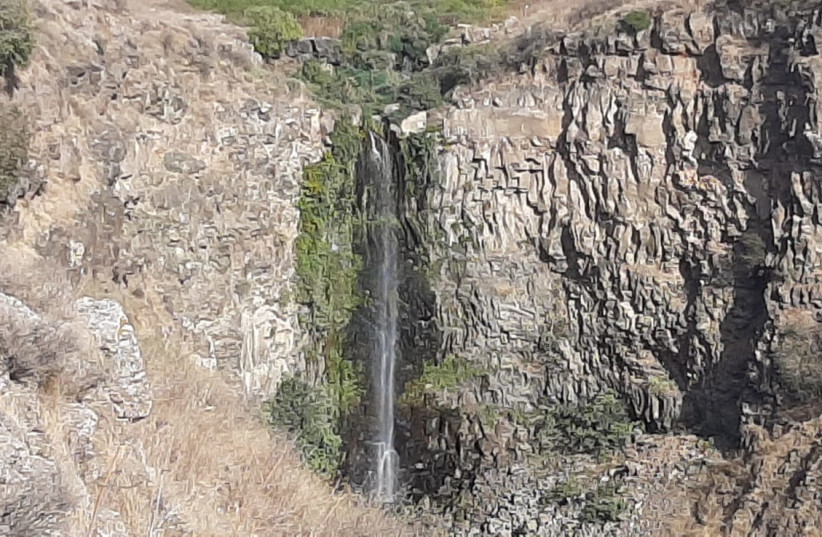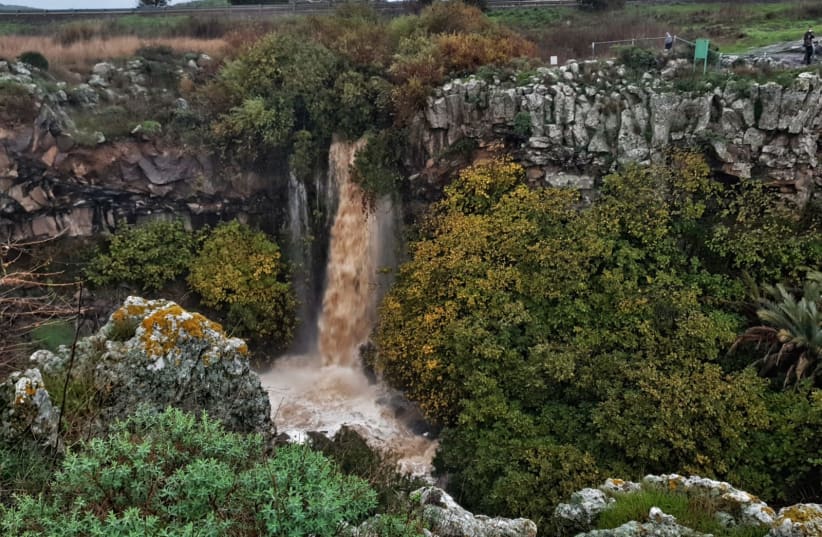In some desperately needed good news, this year’s rainfall has shattered records. Across the country, vibrant flowers in brilliant hues are blossoming, streams are surging, and natural pools are brimming. View the splendor yourself and visit two of Israel’s most majestic waterfalls with me: Gamla and Ayit, both situated in the picturesque Golan Heights.
Hiking to these waterfalls is an extraordinary experience any time of year, but witnessing them in late winter, following the rainy season, is truly a sight to behold. As you gaze upon the sheet of water cascading down from the rugged cliffs, you’ll be mesmerized by the enchanting dance of sunlight sparkling on its surface. Drawing nearer to the water, the thunderous roar of the powerful waterfall amplifies, surrounded by the vibrant green of the surrounding vegetation. All of this comes together in a scene that captivates the senses.
1. Gamla Waterfall
Nestled in the heart of the Golan Heights, the Gamla Nature Reserve is home to one of Israel’s tallest waterfalls. Standing at an impressive height of 51 meters, Gamla is just one of the waterfalls you’ll encounter in the nature reserve, situated two kilometers from the Daliyot Intersection. Two streams flow through the Gamla Nature Reserve: Gamla and Daliyot, each offering its own attractions worth revisiting on another day.
The Eagle Trail, a relatively flat and straight path leading to the Gamla Waterfall, commences at the parking lot and meanders past several among the 4,000-year-old dolmens, which are ancient tombs constructed from massive, upright stones supporting a large, flat horizontal stone on top. Before long, you’ll arrive at a spacious balcony offering a stunning vista of the waterfall and the remarkable cliffs, which serve as nesting grounds for eagles.
This is a linear trail that takes approximately 40 minutes to traverse in each direction and is suitable for children. This is the ideal time of year to explore the area, as the path is adorned with an abundance of beautifully colored flowers, such as cyclamens, anemones, poinsettias, and asphodels.


Another nature reserve trail leads to the ancient city of Gamla, encircled by historic walls. This linear path presents a greater challenge and typically takes about two hours to traverse. Among the findings from archaeological excavations on the site are remnants of one of the earliest synagogues discovered in ancient Israel. Remains identified by the Israel Antiquities Authority date back to the Roman period.
Note: While the sight of the rushing water may be enticing for adventure enthusiasts, it’s strictly prohibited to enter the waterfall pool under any circumstances. Furthermore, it’s advisable to avoid visiting the waterfall when the path is muddy and slippery, especially immediately after heavy rainfall.
- Directions: Drive along Road 808. About two kilometers after the Daliyot Intersection, you will see a sign for the Gamla Nature Reserve.
- Price: Entrance fee NIS 38 for adults; NIS 14 for children.
2. Ayit Waterfall
Another lovely waterfall in the Golan Heights is Ayit (Hebrew for “eagle”), within the Yehudiya Nature Reserve. It stands out as one of the most accessible waterfalls in Israel. Thanks to the substantial rainfall, Ayit is currently gushing with water. Conveniently located near the road, ample signage directs visitors to the nearby parking lot.
Just a five-minute walk from the trail head, you will reach an outlook offering a stunning view of the waterfall. This is the path for those who may find longer walks challenging. The waterfall itself is settled within a relatively narrow and rocky channel, with the water cascading down forcefully into the deep basalt stone canyon below. The abundant water has triggered a profusion of cyclamens and daffodils blooming all around the basin of the pool; this is the only time of year you will find these flowers in this location.
The water from the Ayit Waterfall flows into the Yehudiya Stream, which then continues onward to the Kinneret. An intriguing geological phenomenon you’ll encounter at the waterfall is the hexagonal basalt pillars in the cliff face; their unique shape is a result of the lava’s rapid cooling as it surges out of the earth.
I then recommend continuing along the short path that crosses over the Ayit Stream on a bridge, allowing you to view the waterfall from the opposite bank. Here, you’ll discover a field adorned with the spherical yellow blossoms of spurge shrubs, along with anemones and cyclamens. And if you have the opportunity to revisit this spot later in the spring, you will be see a completely different array of flowers and plants that thrive as the temperature rises.
Once you’ve completed your visit to the waterfall, I recommend taking a five-minute drive to the Artist Village in Aniam. This charming village features a pedestrian mall with art galleries and studios alongside secondhand boutique shops, quaint cafés, ice cream parlors, and spas offering treatments such as fish pedicures. Since many of these establishments may not be open in the evening, it’s advisable to plan accordingly and ensure you arrive at the Artist Village in time to fully enjoy it.
- Directions: From the Kfar Nahum Intersection, turn onto Road 87, and then turn right at Hamapalim Intersection toward Aniam. Pass the turnoff into Aniam, and continue driving until you reach the Ayit Waterfall parking lot.
- Cost: Entrance to the nature reserve is free of charge.
Translated by Hannah Hochner.
